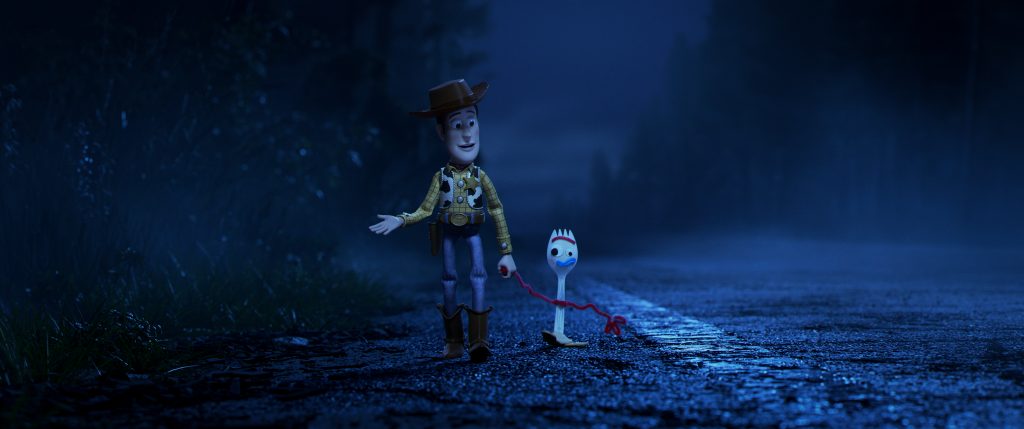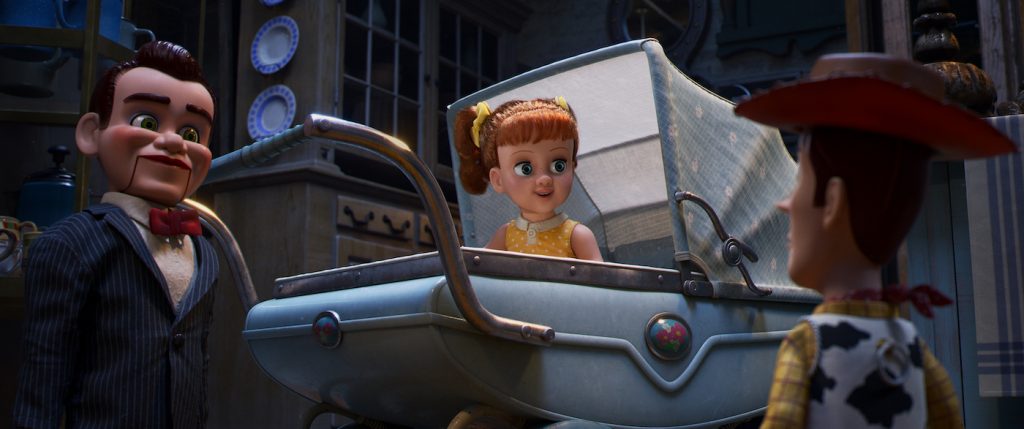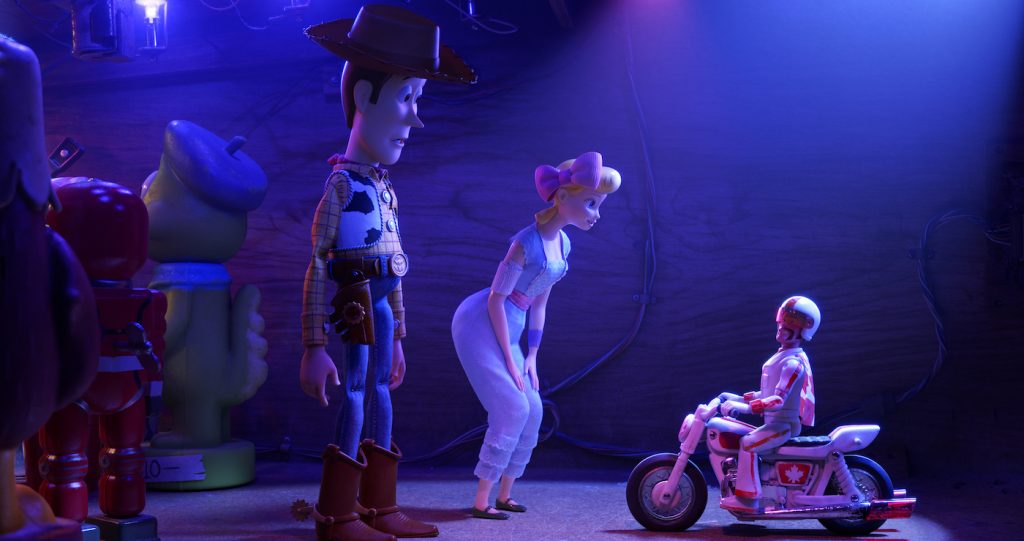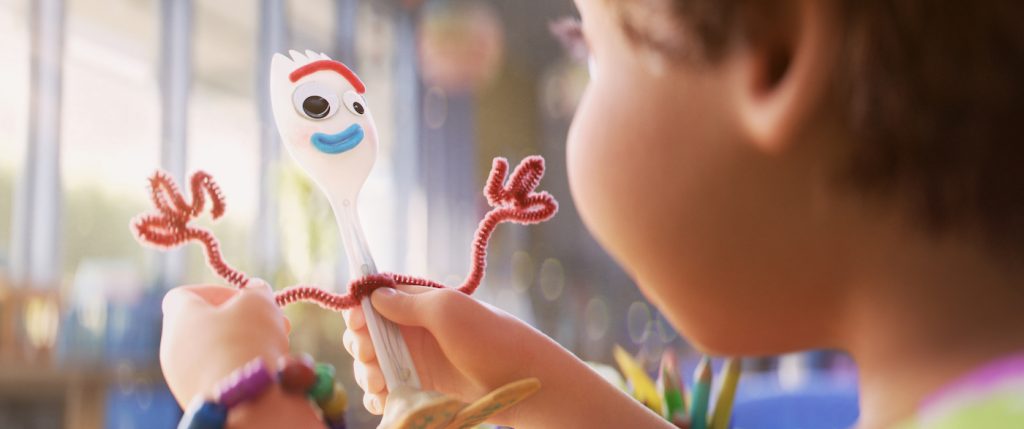Toy Story 4‘s Story Supervisor Valerie LaPointe on Bo Peep, Gabby Gabby & More
The trilogy of the first three Toy Story installments may have seemed complete, but Woody, Buzz, and the rest of the gang are back for another round in director Josh Cooley’s addition to the franchise, and they’ve got a new set of responsibilities to the child in their life, Bonnie. The story gets going with the tyke’s reluctant entry to pre-school, a topic of much debate among her playthings. Woody (Tom Hanks) is no longer top toy, but nonetheless wrangles his way into her backpack to take care of her, getting more than he bargained for when his surreptitious help during craft time results in the creation of Forky (Tony Hale), an animate being made from a spork and googly eyes. Forky, however, doesn’t want to be a toy, he wants to be trash. The responsibility Woody assigns himself to maintain Bonnie’s happiness now depends on keeping this popsicle stick-footed newbie from throwing himself away. The job only gets harder when Bonnie’s family embarks on a road trip.

Besides dragging Forky back to Bonnie’s clutches and convincing him of the nobility of his position as the child’s beloved object, Woody also has to come to terms with the point he’s reached in life. He’s not a priority for Bonnie. He’s also pining for Bo (Annie Potts), the porcelain doll component from Andy’s sister’s Little Bo Peep lamp, now relegated to a hand-me-down box. Bo, previously a minor character, blasts into the story via a realistic rolling skunk when she’s rediscovered at a country carnival, living a committed life as a renegade lost toy. The means by which she ended up here is adjacent to the fair: her lamp has ended up in a neighboring antique store, which is also home to another typically girls’ toy — Gabby Gabby (Christina Hendricks), a vintage baby doll with a dysfunctional voice-box. With sinister intentions behind her disarming sweetness, Gabby and her army of silent dummy dolls go after Woody’s voice machinery. As befits this franchise, however, Gabby’s ploy isn’t merely to serve her own ego — what she wants, by way of Woody’s voice-box, is to finally make it off the antique store’s dusty shelves and into the arms of a loving child.

We had the chance to speak with Valerie LaPointe, the film’s story supervisor and a longtime Pixar creative, about beefing up Bo’s character, balancing Gabby between the edge of good and evil, and crafting Forky, the first child-made toy of the series, for full hilarity.
How has the animation process changed during your time at Pixar?
We have the most amazing animators. Because you can do everything doesn’t mean you necessarily want to. Having limitations and restrictions on how you make things move and look creates a better reality, that we want to go into. I know they specifically made choices in how they limited the movement for Bo, because she’s made of porcelain. Or, Gaby is a plastic doll. They like to think of truth to materials — how would she actually move if she came alive and was walking around? So they created built-in limitations for themselves with movement, and that only heightened the humor. Especially for Forky — I thought well, he’s made of a spork, play-dough, and sticks, how would he move? And it creates just the most hilarious thing. If they’d animated him smoothly moving, it wouldn’t give you any humor at all. It’s all in the way they chose to limit themselves.

Forky stands out for being created by a child as well as his capacity for comedy. How did his final form take shape?
It was definitely one of those days in the story room where, you know, the director’s there, Josh, there are different story artists, and we’re all goofing off with ideas and one of them came up with the thought that Bonnie would make a toy. Everyone has that moment thinking that’s crazy, how would that even work? Then we start philosophizing — when does the toy come to life? How do we explain that? And then somebody did a doodle of her just picking up a spork and putting googly eyes on it. Then everybody was simultaneously doing funny drawings of that spork character, and out of that, he was born. As soon as he was in our story reel, people loved him instantly. There was no way he was going away, he was just comedy gold.

How did Gabby Gabby not only come to be, but also to push Woody’s storyline as she did?
I remember bringing it up, what if we had a baby doll character? And we thought there should be more things like that, toys that girls would relate to. I remember bringing it up because my mom always wanted the Mattel version of that doll when she was a kid in the 50s. We had one in our house, and it was funny how it was the doll that was my mom’s — my dad found it for her when she was an adult, so it was this doll that sat up on this shelf and we weren’t allowed to touch her. Eventually, when we were trying to think about what would happen to Woody, the idea came up about the pull string. And then I remember pitching them that she was a mirror version of Woody — what if he had never had the life he’d had? Woody would have to come to realize this character who never got to experience what it was like to be with a kid. And then we thought it’d be really interesting to present a villain character who we turn, we change. She evolves. And she’s not really a villain. So that would be unexpected, especially in a Toy Story film.
Gabby’s dummies also did some of her dirty work for her. Were they supposed to be as scary as they turned out?
It’s funny with the dummies. They definitely have this creepy vibe, which I think helps in the sense of letting them be the villains who also don’t talk, so we can redeem Gabby at the end. It’s definitely Josh’s sense of humor to throw them in there, but I was just saying the other day how my five-year-old, as soon as they came on screen, said “I don’t like those guys! Why are they in the movie?” And I laughed so hard because she’s part of the reason they are. We have one of those puppets and my husband used to joke around and make it “talk” to her when she was about a year old. I have these funny videos of her talking to it and hugging it, and I’d bring them to work and show them and they’d say, that’s hilarious. And then I brought the dummy into the story room, where he lived for four or five years, and he found his way into the movie.
Bo Peep isn’t new, but she really comes into her own in this film. How did that evolve?
At a certain point when we decided to take Bo in this direction, being a lost toy, and really pushing her in a new way, we formed a group called Team Bo. It was a lot of women but also men across departments, in art, animation, and story. We really worked collaboratively, deciding who she would become in this film and how she’d behave. I was the one kind of holding down the fort in story and edit, I think, tracking how she was evolving and her sense of humor, then passed the torch to the next department as the film went along.
She also gets a sidekick, the minute Giggle McDimples (Ally Maki).
At some point, we realized it would be great to have a character for Bo who was her friend. She travels around with her and is her confidante. Just like with Forky and Woody, we can hear what’s going in Bo’s mind through her. Giggle started out as a tiny little character with her own little compact, and at some point, we thought, what if she was pet patrol? I wanted to give some more layers to her, something more interesting to grasp onto. And then it felt really perfect for her because we instantly knew who this character is. I remember Bob Pauley in art going, now I know how to design her because she’s so specific. And it felt great to make her a cop because Woody’s a sheriff, and Buzz Lightyear’s a star command ranger, so she could have a way of connecting with them on a level, as well.
The lost toys’ motorized skunk is wacky and wonderful. But why a skunk?
I know there was a lot of thinking about well, if Bo’s going to be a lost toy, how would she get around? We threw out so many ideas. Would she walk around on high wires, the way a squirrel moves? And somehow it came up that a skunk is the animal you’d avoid, no matter what. It just seemed like a funny idea but also very utilitarian, that she’d mask herself as something in nature that everyone tries to avoid.
Have you gotten to witness kids watching the movie?
I just took my daughters and nieces to see it. I felt pretty strongly about making Bo’s character really great — dimensional, interesting, not your typical female character in any way. My daughters had their Bo Peep costumes on because we just went to the Disney store, and it was really great to see my almost-six-year-old watch it. She just loved Bo Beep. Every time she was on screen she had to match her outfit. If Bo had on a cape she put it on a cape. If she had it on as a skirt, she put it on as a skirt. She was completely enamored with her, so that was really satisfying and rewarding to see.
Featured image: FRIENDS IN LOW PLACES — In Disney and Pixar’s “Toy Story 4,” the toys find themselves in the dusty shadows of Second Chance Antiques—a massive set that had to be stocked with thousands of objects, creating nooks and crannies that serve as the toys’ secret corridors. Featuring Annie Potts, Tom Hanks, Tim Allen, Jordan Peele and Keegan-Michael Key as the voices of Bo Peep, Woody, Buzz Lightyear, Bunny and Ducky, “Toy Story 4” opens in U.S. theaters on June 21, 2019. ©2019 Disney/Pixar. All Rights Reserved.



